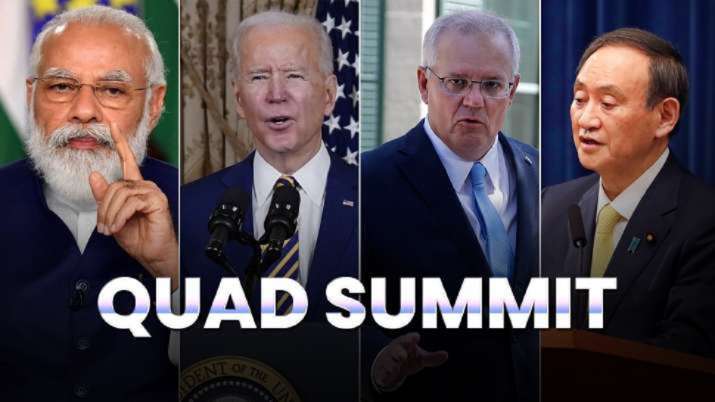
From the 2004 Tsunami to COVID: A Timeline of the Quad Elevation.
Nearly 17 years after the deadly 2004 tsunami, when outgoing Japanese Prime Minister Yoshihide Suga, Indian Prime Minister Narendra Modi, Australian Prime Minister Scott Morrison and US President Joe Biden will meet in person for the first time on September 24 for a leader-level summit . The quadrilateral security talks will mark a high point in China’s growing economic and military might and a year-long high against the backdrop of COVID-19.
Supply chain resilience in critical and emerging technologies such as COVID-19 vaccine production and distribution, semiconductors and 5G telecom networks is at the top of the agenda.
For India’s Prime Minister Narendra Modi, the quad meeting will be booked by a Covid-19 summit organized by Biden and Modi’s own speech at the United Nations General Assembly on Saturday.
The COVID-19 summit is at the heart of Quad’s most pressing priorities – and India’s strength in vaccine production.
Over the past 17 years, the Quad has taken a misguided path to its current prominence, with the shadow of China being a central theme.
In early 2021, Quad returned to the big stage after a nearly 10-year hiatus.
Starting with its roots in Crisis, here’s a timeline that captures some of the key moments that have embraced the Quad closely:
2004: The first framework for the Quad emerged when the United States, Japan, India and Australia formed a “core group” during the joint response to the 2004 tsunami.
2006: While in Tokyo, Indian Prime Minister Manmohan Singh announced that Japan and India wanted to initiate dialogue with other “like-minded countries in the Asia-Pacific region”. In the same year, Japanese Prime Minister Shinzo Abe proposed the “Arc of Freedom and Prosperity”.
2007: In August, Japanese Prime Minister Shinzo Abe’s “confluence of two seas” speech laid the ideological foundation for the Quad. Speaking in the Indian Parliament, he said, “The Pacific and the Indian Ocean are now bringing a dynamic coupling as a sea of freedom and prosperity. A ‘broad Asia’ that has broken geographical boundaries is now beginning to take on a different form. Our two countries have the capacity and responsibility to ensure that this is even more widespread and nurture and enrich these seas so that they become seas of clear transparency.”
2007: The Quad countries held their first official meeting in Manila. The Prime Ministers of India, Japan and Australia met the then US Vice President Dick Cheney on the sidelines of the ASEAN Regional Forum (ARF). In the same year, within four months of the first meeting, the Quad countries along with Singapore conducted an ambitious naval exercise in the Indian Ocean. But the downplaying went on in parallel. Australia framed the Quad as a construction limited to trade and culture, with India saying the Quad had “no security implications.”
2007: Prime Minister Shinzo Abe, a champion of the Quad Grouping, resigned in September 2007. Quad lost its most outspoken champion.
2008: Soon after the 2007 Malabar exercise, Australia dropped out of the quad. Subsequently, Australia was dropped from the 2008 Malabar exercise. More than a decade later, in a 2019 article, former Australian PM Kevin Rudd pointed out that in 2008, throughout the day of meetings with President George W. was not even picked up. . The group split up. Between Quad 1.0 and the 10 years since its revival, four countries aligned with Minilateral. Japan and India became important fixtures in two such arrangements. A steady string of “2+2” bilateral and trilateral took off between the foreign and defense ministers.
2011: After the Great East Japan Earthquake, Japan received heavy support from the US, Australia and India.
2012: Shinzo Abe returned to office and wasted no time invoking the “democratic security diamond”.
2013-2020: During this period, each of the Quad countries saw its share in China’s aggression. India dealt with four Chinese border invasions in 2103, 2014, 2017 and 2020.
2017: Japan announced plans to propose top-level talks with the US, India and Australia. The declared intention was to counter the Chinese invasion.
2017: Later this year, Australia rejoined Quad Partners. Senior officials met on the sidelines of the ASEAN summit in Manila. The biennial meetings continued at the “Senior Officer” level. Japan-India civil nuclear cooperation agreement is also being signed this year.
2019: First Ministerial Meeting of Quad 2.0.
2020: All the four navies participated in their first joint exercise in more than a decade in November.
2021: In March, US President Joe Biden convened a virtual quad meeting that was attended by Australian Prime Minister Scott Morrison, Indian Prime Minister Narendra Modi and Japanese Prime Minister Yoshihide Suga. They set up working groups on COVID-19 vaccines, climate change, and technological innovation and supply-chain resilience.
2021: The first leader-level in-person summit to be held at the White House on September 24.
.